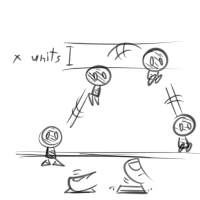There's one thing that has been puzzling me, and that is how to implement a 'faux-impulsed' jump in a platformer. If you don't know what I'm talking about, then think of the jumps of Mario, Kirby, and Quote from Cave Story. What do they have in common? Well, the height of your jump is determined by how long you keep the jump button pressed.
Knowing that these character's 'impulses' are built not before their jump, as in actual physics, but rather while in mid-air - that is, you can very well lift your finger midway of the max height and it will stop, even if with desacceleration between it and the full stop; which is why you can simply tap for a hop and hold it for a long jump -, I am mesmerized by how they keep their trajetories as arcs.
My current implementation works as following:

While the jump button is pressed, gravity is turned off and the avatar's Y coordenate is decremented by the constant value of the gravity. For example, if things fall at Z units per tick, it will rise Z units per tick.
Once the button is released or the limit is reached, the avatar desaccelerates in an amount that would make it cover X units until its speed reaches 0; once it does, it accelerates up until its speed matches gravity - sticking to the example, I could say it accelerates from 0 to Z units/tick while still covering X units.
This implementation, however, makes jumps too diagonal, and unless the avatar's speed is faster than the gravity, which would make it way too fast in my current project (it moves at about 4 pixels per tick and gravity is 10 pixels per tick, at a framerate of 40FPS), it also makes it more vertical than horizontal. Those familiar with platformers would notice that the character's arc'd jump almost always allows them to jump further even if they aren't as fast as the game's gravity, and when it doesn't, if not played right, would prove itself to be very counter-intuitive. I know this because I could attest that my implementation is very annoying.

Has anyone ever attempted at similar mechanics, and maybe even succeeded? I'd like to know what's behind this kind of platformer jumping. If you haven't ever had any experience with this beforehand and want to give it a go, then please, don't try to correct or enhance my explained implementation, unless I was on the right way - try to make up your solution from scratch. I don't care if you use gravity, physics or whatnot, as long as it shows how these pseudo-impulses work, it does the job.
Also, I'd like its presentation to avoid a language-specific coding; like, sharing us a C++ example, or Delphi... As much as I'm using the XNA framework for my project and wouldn't mind C# stuff, I don't have much patience to read other's code, and I'm certain game developers of other languages would be interested in what we achieve here, so don't mind sticking to pseudo-code.
Thank you beforehand.
